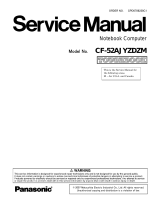
1-2 Product Information HP Omnibook 6000/6100
Omnibook
Product * CPU ** Display
Hard
Drive Drives
Standard
SDRAM Communication
F2198
xy
Pentium III 700 MHz 14.1” XGA 7.5 GB CD-ROM, FDD 64 MB None
F2200
xy
Pentium III 900 MHz 14.1” XGA 20 GB DVD, FDD 128 MB Modem/LAN
F2201
xy
Pentium III 900 MHz 14.1” XGA 20 GB DVD, FDD 128 MB None
F2202
xy
Pentium III 1.0 GHz 15.0” XGA 30 GB DVD, FDD 128 MB Modem/LAN
F2203
xy
Pentium III 1.0 GHz 15.0” SXGA+ 30 GB DVD, FDD 128 MB None
Omnibook 6100
F3257
xy
Pentium III-M 933 MHz 14.1” XGA 10 GB CD-ROM, FDD 128 MB Modem, LAN
F3258
xy
Pentium III-M 933 MHz 14.1” XGA 10 GB CD-ROM, FDD 128 MB None
F3259
xy
Pentium III-M 933 MHz 14.1” XGA 10 GB CD-ROM, FDD 128 MB Modem, LAN, Wireless LAN
F3260
xy
Pentium III-M 1.0 GHz 14.1” XGA 20 GB DVD, FDD 128 MB Modem, LAN
F3261
xy
Pentium III-M 1.0 GHz 14.1” XGA 20 GB DVD, FDD 128 MB None
F3262
xy
Pentium III-M 1.0 GHz 14.1” XGA 20 GB DVD, FDD 128 MB Modem, LAN, Wireless LAN
F3263
xy
Pentium III-M 1.13 GHz 15.0 ” SXGA+ 30 GB DVD, FDD 256 MB Modem, LAN
F3264
xy
Pentium III-M 1.13 GHz 15.0 ” SXGA+ 30 GB DVD, FDD 256 MB LAN
F3265
xy
Pentium III-M 1.13 GHz 15.0 ” SXGA+ 20 GB DVD, FDD 256MB Modem, LAN, Wireless LAN
F3266
xy
Pentium III-M 933 GHz 14.1 ” XGA 20 GB DVD, FDD 128 MB Modem, LAN
F3267
xy
Pentium III-M 933 GHz 14.1 ” XGA 20 GB DVD, FDD 128 MB None
F3268
xy
Pentium III-M 933 GHz 14.1 ” XGA 20 GB DVD, FDD 128 MB Modem, LAN, Wireless LAN
This table lists only base product configurations—custom configurations are not included.
* For the products listed, the “
xy
” suffix means: “W” for Windows 95 or Windows 98, “K” for Windows 2000 , “H” for Windows
XP Home, “J” for Windows XP Professional. A “
y
” suffix (none, “T”, “G”, or “U”) is a marketing distinction only.
** Intel Mobile Pentium III or III-M with SpeedStep Technology or Intel Mobile Celeron processor.
Table 1-2. Product Comparisons
Omnibook 6100 Omnibook 6000 Omnibook 500
Processor*
Pentium III-M (933 to 1133
MHz).
Celeron (550 to 750 MHz) or
Pentium III (600 to 1000 MHz).
Celeron (500 or 600 MHz) or
Pentium III (600 to 750 MHz).
Memory
128 or 256 MB PC-133
SDRAM in system slot.
Expandable to 1024 MB.
64 or 128 MB PC-100 SDRAM
in system slot. Expandable to
512 MB.
64, 128, or 256 MB PC-100
SDRAM in system slot.
Expandable to 512 MB.
Display
15.0-inch TFT SXGA+ or
14.1inch TFT XGA.
15.0- or 14.1-inch TFT XGA, or
15.0-inch TFT SXGA+.
12.1-inch TFT XGA.
Video
AGP 4X graphics interface.
16 MB DDR video RAM with
64-bit graphics interface.
3D and OpenGL graphics
support.
Up to 16M colors (UXGA).
Zoomed Video enabled.
AGP 2X graphics interface.
4 or 8 MB video RAM with 32-
or 64-bit interface
3D and OpenGL graphics
support.
Up to 64K or 16M colors
(UXGA).
Zoomed Video enabled.
AGP 2X graphics interface.
4 or 8 MB video RAM with 32-
or 64-bit graphics interface
and 64-bit graphics controller.
3D and OpenGL graphics
support.
Up to 64K or 16M colors
(UXGA).
Zoomed Video enabled.
Operating
System
Windows 98, Windows 2000,
or Windows XP preinstalled.
Windows 95, Windows 98, or
Windows 2000 preinstalled.
Windows 98 or
Windows 2000 preinstalled.
HP Toptools
HP Toptools 5.5 HP Toptools 4.5 to 5.0. HP Toptools 5.0.
Power
Management
APM 1.2.
ACPI compliant.
APM 1.2.
ACPI compliant.
APM 1.2.
ACPI compliant.
Power States
On, Standby, Hibernate, Off. On, Standby, Hibernate, Off. On, Standby, Hibernate, Off.
* Intel Mobile Pentium, Mobile Pentium-M, or Mobile Celeron Processor. Dual-speed processors use Intel
SpeedStep Technology.






















